
Indian cinema turns a year older tomorrow, but even after an eventful journey of 101 years, it is still in its prime – vibrant and growing. On this landmark occasion, let us have a look at some of the iconic movie-makers of the past who made Indian cinema what it is today.
On May 8, 1912, Ramchandra Gopal Torney or Dadasaheb Torney, as he was fondly called, filmed a Marathi play titled Shri Pundalik while it was being played on stage and thus made the first feature film of India, Pundalik. But as this movie was sent overseas for post-production processing, it is not formally recognised as the first child of Indian cinema. It was Dhundhiraj Govind Phalke, aka
Dhundhiraj Govind Phalke, popularly known as Dadasaheb Phalke, was a Mumbai-based photographer, printer, painter and magician. He moved to cinematography after watching Life of Christ at a Christmas cinema show. In his brief career of 19 years, he had made 95 movies and 26 short films. Some of his noted flicks include Mohini Bhasmasur, Satyavan Savitri, Lanka Dahan, Shri Krishna Janma and Kaliya Mardan. He has been bestowed a place of honour in the Hindi film industry and the most prestigious award for contribution to the Indian cinema has been named after him. He is also regarded as the Father of Indian Cinema.
While movie enthusiasts are pretty familiar with Dadasaheb Phalke, there were other pioneers during his time who also played a pivotal role in shaping the Indian cinema.
Dhirendra Nath Ganguly (Early 1920s to late 1950s)
Hailing from Kolkata, he specialised in satirical Bengali comedies. The first movie to come out of his production house, in 1921, was Bilat Ferat (English title: England Returned), which he had written, produced and acted in. It was directed by Nitish Lahiri. Some of the movies directed by Ganguly were Country Girl, Takay Ki Na Hay and The Marriage Tonic. It was the first movie to show intimate scenes, inspired by its British and American equals.
Chandulal Shah (1930s to 1960s)
A Gujarati film-maker from Mumbai, he made silent movies dealing with social issues. His noted movies included Typist Girl, Gunsundari, and Barrister’s Wife – all of them starring Gohar Kayoum Mamajiwala, also known as Miss Gohar. In just three years, Shah made around 40 pictures. He also owned the famous Ranjit Studios, in partnership with Miss Gohar.
Himanshu Rai (Early 1920s to late 1930s)
After meeting playwright Nirnanjan Pal in London, he came in contact with Franz Osten, a German filmmaker, and made some of the classic Indian films including The Light of Asia, Shiraz, A Throw of Dice and Karma. Rai also immortalised his wife Devika Rani as the first lady of Indian cinema, as he cast her in the landmark movie Acchut Kanya.
Picture courtesy: Rollingframes
